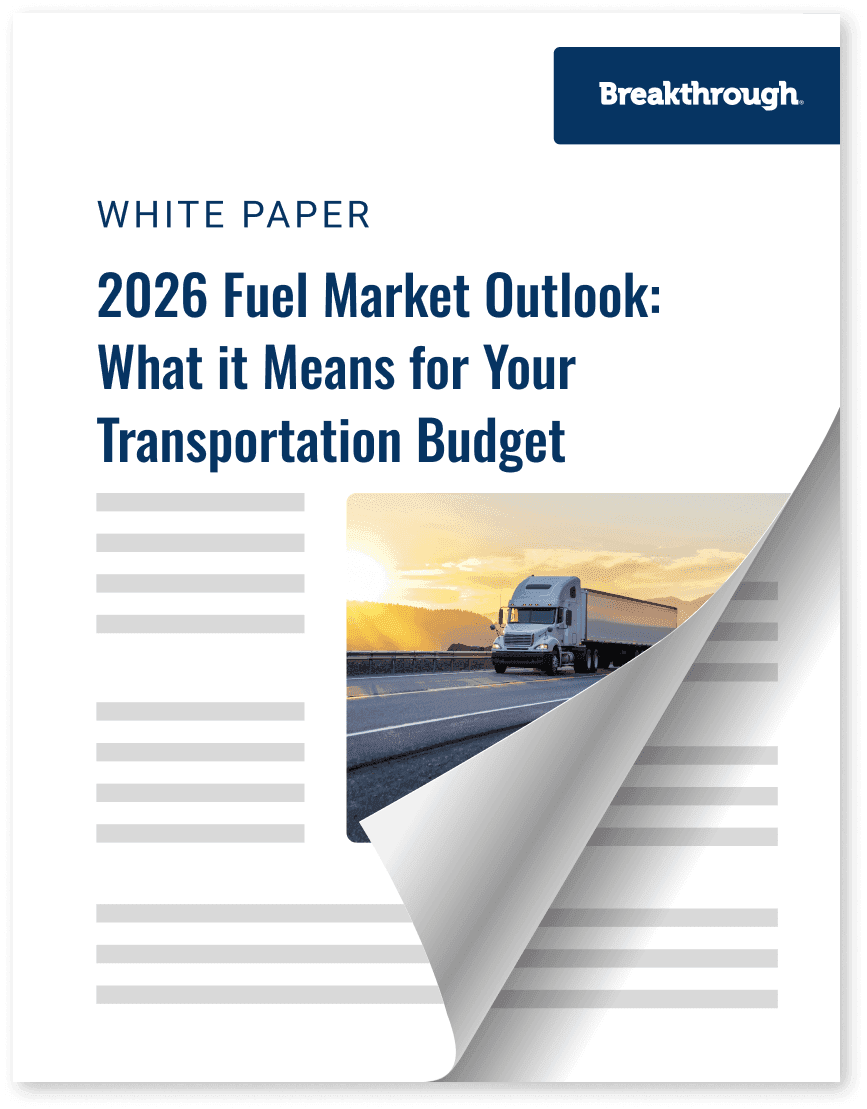2026 Fuel Market Outlook: What it Means for Your Transportation Budget

Trending
Top Posts
4 min read
May 30, 2025

Share:
Table of contents
Browse the table of contents to jump straight to the part you’re looking for
When Breakthrough surveyed their shipper clients last August at The Mercury Group, they overwhelmingly predicted a freight market flip in Q2 2025. Yet, Q2 has come and gone, and increased freight demand remains elusive. According to Breakthrough's ecosystem of real-time, shipper-transacted data, April marked the third consecutive month of volume declines across most sectors—with the exception of paper and packaging.
Projections from Breakthrough's Chief Economist, Matt Muenster, suggest that gradual linehaul rate increases may begin by late Q3 2025 and continue into 2026. But for now, transportation leaders are grappling with macroeconomic pressures, trade policy uncertainty, and sustainability goals that make adaptive strategies essential. In this uncertain landscape, transportation leaders are embracing innovative practices and rethinking traditional RFP strategies to stay ahead.
The transportation industry is taking a more tactical approach to maneuver through the current uncertainty. According to our 2025 State of Transportation Report, both shippers and carriers are rethinking their operations and developing new strategies to adapt effectively ahead of the anticipated market flip. Here's a closer look:
How Shippers Are Preparing
How Carriers Are Responding
Carriers are eagerly waiting for an uptick in freight demand, with 49% planning to expand their fleet size or services once market conditions improve. However, current market dynamics have constrained their ability to invest in new equipment, which could jeopardize relationships with the 37% of shippers now prioritizing partnerships with more sustainable carriers. As 30% of shippers turn to alternative energy to make progress toward their sustainability goals, carriers are under pressure to align their expansion plans with environmentally friendly investments.
Adaptability is key for both shippers and carriers in this volatile landscape. Shippers are focused on cost-cutting strategies and are using innovative solutions to make small yet impactful adjustments to their networks. For example, shippers are stacking wins using compliance monitoring tools to address deviations from RFP plans to maintain budget and using trusted benchmarking tools to identify outlier lanes. Carriers, on the other hand, are prioritizing adaptability by forging stronger partnerships with shippers to better align on expectations and proactively address challenges before they initiate their next RFP.
The freight market continues to be uncertain, requiring stakeholders to think of adaptive and innovative strategies to build a competitive advantage. In these challenging conditions, one key lesson stands out: resilience requires doing more in this year's RFP events.
In today’s demanding freight market, committing to more can often feel unattainable. With the constant pressure to optimize operations, reduce costs, and enhance performance, many organizations find it challenging to dedicate the necessary resources to achieve these goals. However, the right technology stack, coupled with advanced AI capabilities, can bridge this gap. By uncovering actionable insights from complex data and streamlining decision-making processes, shippers can maximize efficiency and focus their time on strategic priorities.
Winning in this freight market demands resilience, innovation, and collaboration. While the anticipated freight market flip may be delayed, strategic preparation will give shippers the data they need to achieve results that balance costs with operational efficiency. For a comprehensive analysis of the latest trends and actionable insights from shippers and carriers, download Breakthrough’s 2025 State of Transportation Report.
Transportation RFP Services
Meet with our experts to develop a winning strategy that drives results.


6 min read
November 20, 2025
Understand the impact of Ukrainian drone strikes on Russian refineries. Learn why diesel prices are volatile and how to protect your budget from market shocks.
Read more
7 min read
November 11, 2025
Discover how fuel management systems cut costs, track emissions, and improve reimbursement accuracy for modern freight operations.
Read more
6 min read
November 10, 2025
Explore how the proposed Union Pacific–Norfolk Southern merger could reshape rail in the U.S. Learn impacts on competition, pricing, and service.
Read more